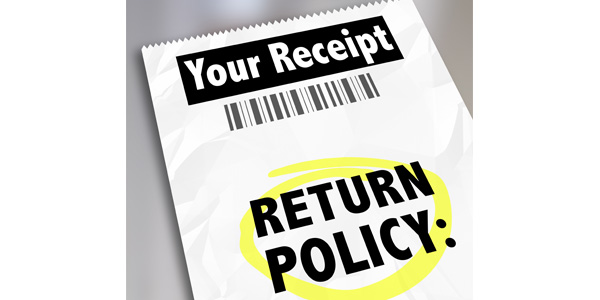
In Stephen King’s short story “Sometimes They Come Back,” the main character is haunted by a ghostly gang of deceased punks from his youth. He never expected them to return, but they have, and nobody is happy to see each other. It’s a lot like customer returns, actually!
Returns are a hassle – for the store and the customer. While we can’t eliminate returns completely, there are a number of proactive ways to reduce the frustration and frequency of these transactions. The most effective is to fully communicate with your customer. Obtaining the relevant vehicle information and understanding the customer’s expectations can help reduce returns of incorrect or unsatisfactory product. Fully explaining your responsibilities as a seller can help to limit the number of questionable return transactions.
Every store has policies in place to govern returns. These policies have been set forth to protect the store from getting stuck with obsolete, non-stocking or unsaleable merchandise, and to ensure the store receives full credit for the returned items they send back to their own supplier or distribution centers. For independent stores, special-order parts may be sourced from a number of individual vendors, whose return policies may differ from those of their main supplier. Ultimately, you’re responsible for knowing what you can and cannot take back as new, defective or as a core return. Once the transaction is completed, you’re stuck with that part.
New returns should be just that – NEW! Items that have been “tried on” or “tested” (especially electrical parts) are NOT new anymore, and the next customer who receives the part isn’t going to be satisfied with receiving a dirty, damaged or otherwise used part. “New” items returned with damaged or missing packaging are not considered saleable, and reselling worn or damaged stock looks bad for you and your company. Unsaleable merchandise that can be returned to your supplier for credit needs to be separated from active stock until it’s returned. Unsaleable merchandise that your store cannot recover any credit for should be politely refused, citing the store’s return policies.
Be Consistent
Easing return anxiety begins with the original sale. Many customers already are interested in the warranty attached to the parts they’re purchasing, so this is the perfect time to cover the return policy. They are actively listening to you to receive the information they want, so adding the relevant return information at this time helps solidify this policy. If returns are only accepted for a limited amount of time after the sale, let the customer know that. It may come as a surprise to you, but customers rarely read the invoice you give them, and hardly any bother with the tiny printing that states your return policies. Remind them to keep their receipt, and point out that it contains important warranty and return information that they may need later.
For reman items that require a core deposit and return, fully explain the condition in which you expect that core to be returned, and any penalties incurred if the returned core does not meet the minimum return specifications. Some companies require very detailed vehicle and mileage information, along with proof of purchase (which should ALWAYS accompany ANY return!) to process a warranty replacement claim. Customers should be advised to record this information at the time of purchase, rather than trying to “remember” the circumstances of the original purchase, or falsifying these warranty documents. That is fraud, and it hurts everyone in the supply chain!
Speaking of fraud, there are customers out there who are more than willing to attempt to return parts they didn’t buy from you, or may have found cheaper somewhere else, and try to substitute someone else’s part for yours to save a few dollars. Knowing your product lines, and opening the packaging of each returned item to confirm the part is actually yours (and that all the parts are there, in the case of kits or assemblies) not only protects you from return fraud, but it also helps to ensure the part will meet the needs of a future customer if it’s resold. It’s embarrassing (and costly) to sell someone a part that has been reboxed incorrectly, is damaged or previously has been returned as a core or defect. It also costs your customer time and lost labor, and, it’s inconvenient.
When dealing with returns, consistency is a key factor. If the customer knows he can come back during another shift and receive a refund for a part that you refused earlier in the day, that becomes a liability for you and for the company. Every counter professional should uphold the same policy standards and follow the same routines, especially when it comes to returns.







